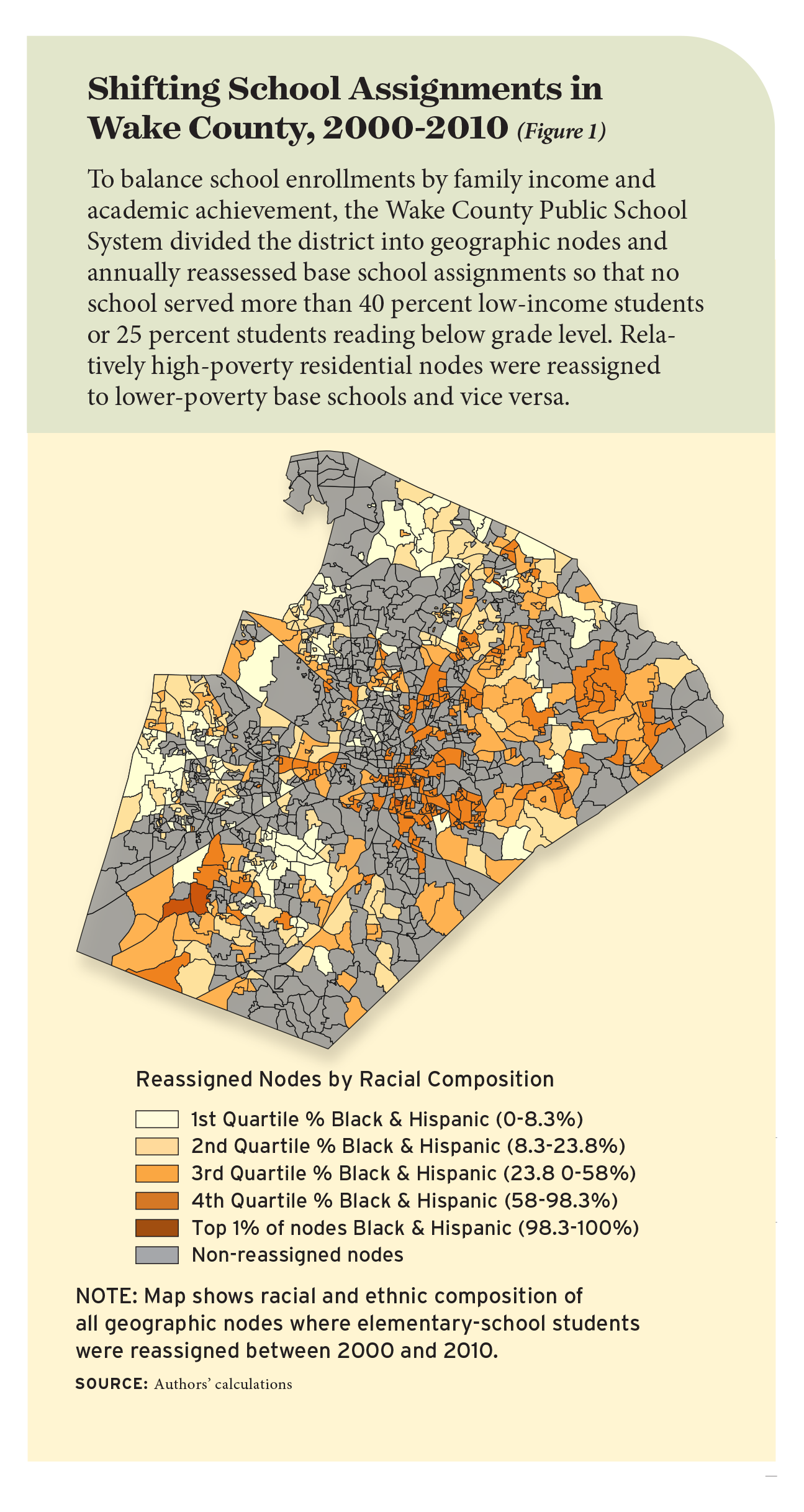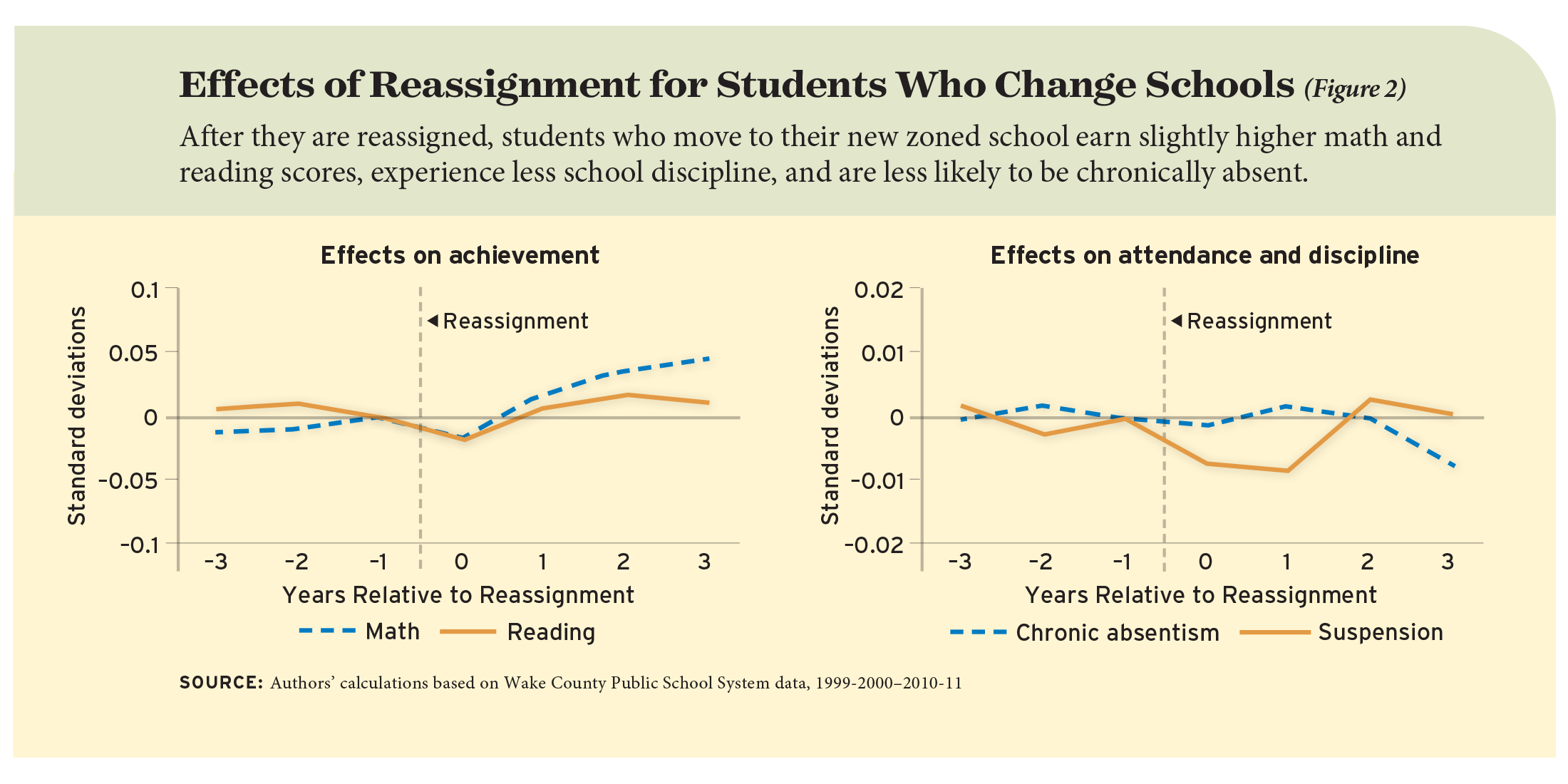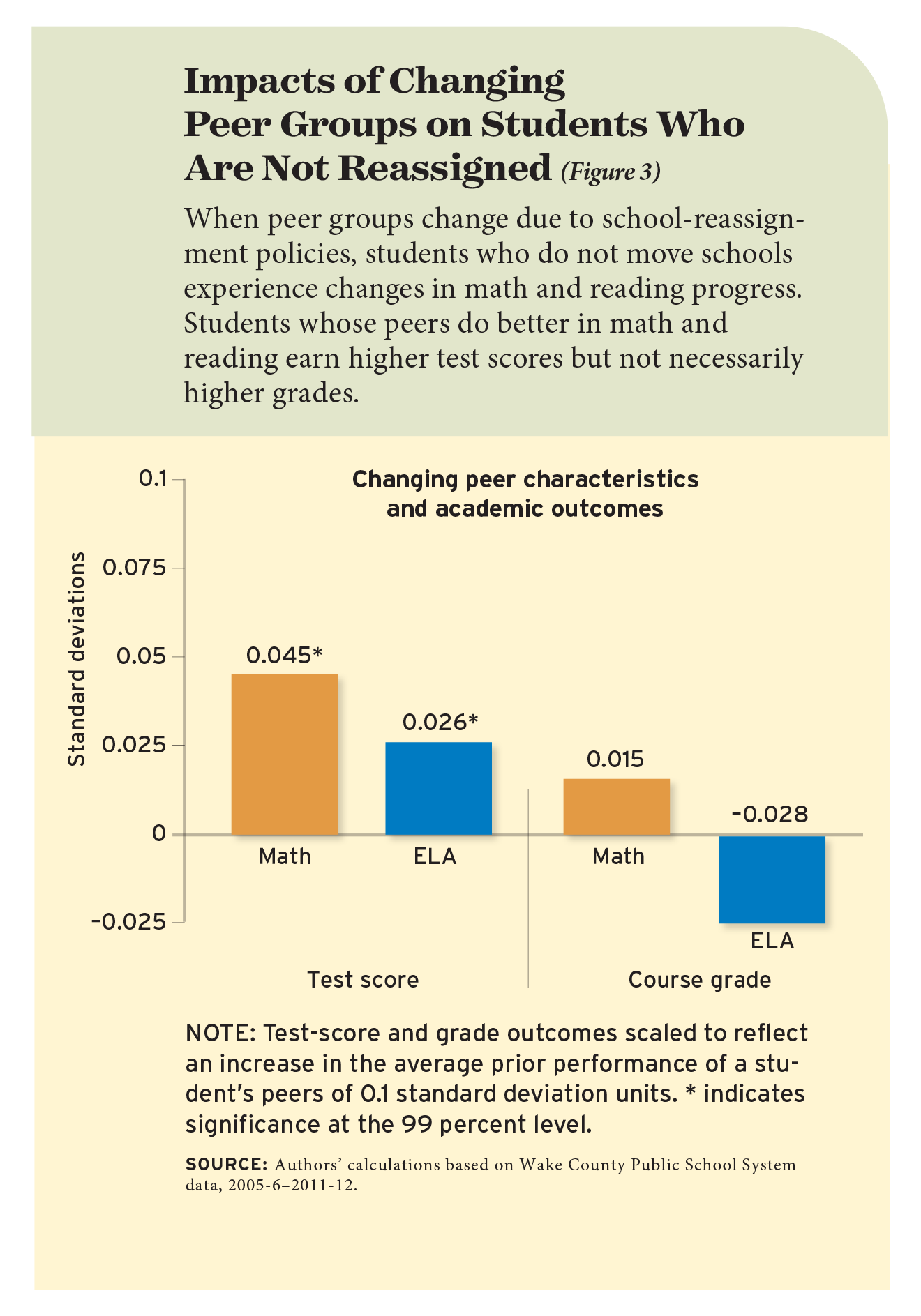 For decades, large public-school systems in the United States have used student assignment policies to foster more diverse school enrollments. Such efforts, sometimes pursued under court order, seek to expand educational opportunity and counterbalance the patterns of residential segregation that contribute to racial and economic isolation, especially in urban centers. They may receive a new source of federal support: the Biden Administration has proposed a $100 million Fostering Diverse Schools grant program to help communities “voluntarily develop and implement strategies that will build more racially and socioeconomically diverse schools and classrooms.”
For decades, large public-school systems in the United States have used student assignment policies to foster more diverse school enrollments. Such efforts, sometimes pursued under court order, seek to expand educational opportunity and counterbalance the patterns of residential segregation that contribute to racial and economic isolation, especially in urban centers. They may receive a new source of federal support: the Biden Administration has proposed a $100 million Fostering Diverse Schools grant program to help communities “voluntarily develop and implement strategies that will build more racially and socioeconomically diverse schools and classrooms.”
“Research suggests that diverse learning environments benefit all students and can improve student achievement, serve as engines of social and economic mobility, and promote school improvement,” Education Secretary Miguel Cardona said in his budget testimony.
One common strategy to create more diverse learning environments is to intentionally balance school enrollments according to students’ socioeconomic and demographic characteristics. Districts can achieve this by physically transporting students to schools outside their immediate neighborhoods or by prioritizing the enrollment of students in schools where they would diversify the student body. The intent is to expand opportunities for students from diverse backgrounds to learn alongside one another, in order to reduce the prevalence of segregated schools, allocate resources more equitably, and improve student outcomes. Indeed, research has found benefits for educational achievement, attainment, and other measures of well-being for Black students where schools were desegregated and resources more equitably distributed.
But school integration initiatives (sometimes referred to as “mandatory busing” or just “busing”) in New York City, San Francisco, Charlotte-Mecklenburg in North Carolina, and elsewhere have sparked substantial backlash, particularly among more affluent families. Their concerns often echo a longstanding claim that school reassignments destabilize communities and exact a social or educational toll on reassigned students and their peers. For example, in 2019, community members submitted hundreds of overwhelmingly negative comments to Maryland’s Howard County Public School System in response to a proposed plan to redraw attendance boundaries to integrate its schools. Among the comments, a prediction: “The only result you will find is more time commuting to school, humiliation, intimidation. Busing children WILL NOT increase individual grade-point averages. In fact, it may decrease all those objectives.”
Critical to informing this debate is a comprehensive answer to the question: How does reassigning students to create schools that are more socioeconomically and academically diverse affect the distribution of educational opportunity? What are the impacts on students who switch schools as a result of these policies? And how do changes in school assignments affect the students who don’t switch schools, but who experience changes in their classmates’ characteristics?
We report the results from two distinct studies of North Carolina’s Wake County Public School System, which has a long history of using student assignment policies to weaken the school-neighborhood links that exacerbate school segregation. Our research teams, one based at the University of North Carolina at Chapel Hill (UNC) and the other originating at the Center for Education Policy Research at Harvard University, have worked closely with the district to better understand how student assignment policies affect academic and behavioral outcomes and how changing the demographic characteristics of a student’s peers affects learning.
We find that, on the whole, school reassignment has somewhat muted effects. In contrast to the sharp criticism and heated controversy that integration programs often inspire, switching schools does not harm students who are reassigned. In fact, reassigned students perform modestly better on statewide tests and are less likely to be suspended. We do find some negative effects for students who switch to schools where achievement and income levels are lower, but these effects are offset by positive impacts for students when school reassignments mean they learn alongside higher-performing and wealthier peers. However, these impacts are small, because, in most cases, students’ new schools are largely similar to the schools they left behind. Put another way, the impacts of school integration rely more on the destination than the departure.
A Decade of Dizzying Growth
Our research emerges from the deep and longstanding commitment to evidence-informed policymaking by district leaders in Wake County. Multiple teams of university-based researchers have cooperated with district staff over the past two decades. Our studies are unique, in that two teams pursued partially overlapping research topics. Taken together, these studies complement one another and provide a more comprehensive assessment of a longstanding student reassignment policy in one of the largest districts to implement such a plan. Satisfyingly, where our questions align, so, too, do our findings, which we believe can serve as a model for how future evaluations of high-priority policy topics might proceed.
Both studies examine school reassignment policies and effects during an era of rapid growth and demographic change in Wake County. Between 2000 and 2010, the number of students jumped by nearly 50 percent, to 143,289 from 98,741. The share of Hispanic students more than tripled, to 13 percent from 4 percent, while the percentage of Asian students almost doubled to 6 percent from 3 percent. During that time, the percentage of white students fell to 51 percent from 64 percent, while the share of Black students shrank slightly to 25 percent from 26 percent. As a result of the population growth, the district opened 40 new school buildings during the decade, most of which were located in relatively more affluent neighborhoods in the county’s suburban fringe. Nearly one quarter of all students were reassigned during the study period.
The UNC study looks at how reassignments affect the 23.9 percent of students who were asked to change schools, including how reassignment changed the characteristics of the schools they attend. It does not find that reassigned students who change schools are adversely affected. On average, after changing schools, reassigned students travel shorter distances and attend higher-performing schools. Their academic performance does not suffer after changing schools, and, in some cases, it actually improves by a small but significant degree. Critically, these results suggest that concerns about the negative consequences of school reassignment for those who were reassigned may be overblown.
The Harvard study asks a different set of questions. What about the larger group of students who don’t switch schools, but whose peer groups are changed due to wide-
scale reassignments? Their academic performance improves too—but only if their peer group changes to include more high-achieving classmates. Students from more affluent families and already high-achieving students benefit the most from peer groups that are also academically high-achieving. But students with lower family incomes and lower baseline academic achievement also benefit from being in class with academically stronger peers. The team does find that students earn lower grades in reading when they experience an influx of higher-performing peers, possibly due to teachers’ practices of relative-rank grading. But overall, the picture is positive.
In particular, our results indicate that students who learn alongside more high-achieving students as a consequence of school reassignment policies have better academic achievement. These results suggest that a policy that reassigns students to optimize the average peer achievement level of less-advantaged students can help accomplish equity goals but, under certain conditions, may also have unintended consequences, particularly for their more-advantaged peers.
A Voluntary Desegregation Effort
Unlike many other large school districts in the South, Wake County was never the subject of court-ordered desegregation. But in the 1970s, under federal pressure to integrate, the majority-Black Raleigh City Schools and majority-white surrounding county district merged to form the Wake County Public School System. To balance the enrollments of the district’s schools, leaders used students’ race as a primary factor in school assignments until a federal court decision ended mandatory desegregation efforts in the nearby Charlotte-Mecklenburg Schools.
In 2000, Wake County shifted to using students’ socioeconomic status and levels of academic achievement in school assignment decisions instead of race. As part of its strategy for meeting these targets, the district was divided into geographic nodes of about 150 students. The district assigned each node to a base elementary, middle, and high school, which served as the default school of attendance for students in the node.
To maintain socioeconomic and achievement balance, Wake County reassigned a small share of students to different base schools each year based on their grade level and node. That is, in a particular year, the policy would assign all students in the same grade and node to the same school. The goal was to balance enrollments such that no school would serve a student body with more than 40 percent of students receiving free or reduced-price lunch and more than 25 percent of students reading below grade level.
Reassignments occurred throughout the district, including nodes in the district’s urban core as well as rapidly expanding suburban nodes at the district’s northern and southern peripheries. Nodes with high concentrations of Black and Hispanic students were more likely to experience reassignment than nodes that included predominately white students (see Figure 1). The district also used reassignments to populate newly constructed schools, most of which were located in relatively affluent, high-growth neighborhoods. These shifts affected between 2 percent and 8 percent of students annually.

District decisionmakers used a range of criteria when reassigning groups of students, including travel distances, capacity constraints, and diversity considerations. These recommendations were presented for community feedback alongside options for students to attend magnet and year-round schools. The annual reassignment process kicked off more than a year in advance, and parents had at least six months to decide whether to accept the newly assigned school or appeal the decision.
This process created several groups of students: students who were reassigned and moved; students who were reassigned and did not move; and students at sending and receiving schools who experienced different peer groups because of node reassignments. In addition, students could choose to attend year-round or magnet schools, though students were guaranteed door-to-door transportation to their base schools but not to magnet programs. About two thirds of Wake County students attended their base schools from 2000 to 2010.
The district’s approach to reassignment enables both research teams to overcome a key challenge in measuring the impacts of school switching or the influence of peers on one another’s learning. Simply examining the outcomes of any reassigned students who change schools or not-reassigned students who share classrooms with peers of different demographic backgrounds would fail to account for unobserved differences that could influence outcomes. In our studies, however, we can compare the outcomes of students in nodes selected to switch schools to those in otherwise similar nodes who were not chosen to change schools. After accounting for the observable characteristics used to inform the assignment process, groups of students from adjacent nodes were selected in an arguably random process to attend different schools. Similarly, to understand the effects of learning with peers from different backgrounds, we examine the outcomes of students who remained in the same school but experienced an as-good-as-random reshuffling of peers assigned into and out of their classes. As a result, both teams have plausible claims to a causal interpretation of their findings.
Impacts on Reassigned Students
Those of us on the UNC team examine how reassignment affected the new schools that students attended as well as its impact on reassigned students’ academic achievement, attendance, and school discipline. We compare student outcomes in the pre-reassignment period to those outcomes in post-reassignment periods and then benchmark those differences against the trend for nodes that were never reassigned. Our analysis is based on district data from 1999–2000 to 2010–11, which includes students’ basic demographic and academic characteristics, home addresses, geographic nodes, and school assignments.
Despite concerns about the potential harms of reassigning students to achieve diversity goals, we find no evidence that reassignment negatively affected student outcomes. In some cases, reassignment modestly boosted achievement and protected students against exclusionary discipline.
First, we examine how reassignment affects the characteristics of students’ assigned schools. Looking at the effects on distance, we find that reassignment reduces the distance between a geographic node and assigned school by one fifth to one half of a mile, on average. However, this surprising overall result masks heterogeneity across racial and ethnic groups. While distances for reassigned white students decline by roughly one mile, distances for reassigned Hispanic students increase by about one mile. There is no change in average travel distance for Black students.
Overall, reassignment results in students attending schools with somewhat higher math achievement, though we find substantial variation across racial and ethnic groups. On average, test-score performance in math at schools attended by reassigned students is 0.02 to 0.05 standard deviations higher compared to their previous schools. For white students, however, math achievement is between 0.02 and 0.07 standard deviations higher at new schools. Black students attend schools where achievement is initially lower than at their previous schools, but this effect shrinks over time. The differences range from 0.05 standard deviations lower one year after reassignment to 0.004 standard deviations lower two years later. There is no change in average school performance for reassigned Hispanic students. In addition, the proportion of students of color is lower in schools attended by reassigned Black, Hispanic, and white students, suggesting that only white students are more likely to be reassigned to schools that included more students who share their racial identity.
We then look at how reassignment affects students who change schools, and we find encouraging results. After reassignment, students’ math achievement improves by a modest amount in all three post-reassignment years, ranging from 0.02 standard deviations in year one to 0.05 standard deviations in year three (see Figure 2). Reading achievement is initially flat but improves by 0.02 standard deviations in year two. Students who are reassigned are also less likely to experience exclusionary discipline in the first post-reassignment year and are no more likely to be chronically absent than before they switched schools. The impact on suspensions is particularly encouraging in light of emerging efforts by policymakers to combat disciplinary practices that disproportionately harm students of color (see “Proving the School-to-Prison Pipeline,” research, Fall 2021).

Wake County students also switch schools to attend the district’s rich set of magnet and year-round calendar schools; during the study period, about one-third of district students attend a public school of choice. We explore whether the main results differ depending on whether reassigned students attend their reassigned base school or opt to attend a magnet or year-round public school. Encouragingly, we find that the effects for achievement, absenteeism, and suspension are broadly similar whether reassigned students attend new base schools or schools of choice.
Peer Effects on Students Who Don’t Switch Schools
Those of us on the Harvard team focus here on students who do not change schools. Because students in similar geographic nodes were not uniformly reassigned, school enrollment changes serve as a series of natural experiments that allow us to compare students’ performance across years in which they experienced more- or less-affluent or higher- or lower-achieving peers.
Unlike students who switch schools, the only aspect of non-reassigned students’ schooling that changed was their peers. Thus, we can home in on just the phenomenon of changes in composition of these students’ classroom resulting from peer in- and out-flow produced by the reassignment policy. Our analysis includes district data from 2005–06 to 2011–12 (a shorter window than the UNC study), when academic standards, tests, and district-assignment policies were relatively stable. We focus on students in grades 7 and 8, who have two years of annual test-score data and typically do not change schools unless they are reassigned.
We find that middle-school students’ academic skills, as measured by standardized test scores, improve when they attend school with higher-achieving peers. Overall, when peer achievement increases by 0.10 standard deviations, students’ test scores increase by 0.04 standard deviations in math and 0.03 standard deviations in reading (see Figure 3).

We also look at non-reassigned students by family income and prior test-score performance. Peer effects are largest for wealthier students, whose test scores increase by 0.05 standard deviations in math and 0.03 standard deviations in reading when their peers’ achievement increases by 0.10 standard deviations. Students with higher test scores get the biggest gains in math from attending school with higher-achieving peers. Students with lower family incomes and lower baseline levels of achievement also benefit from academically stronger peers. When peer achievement increases by 0.10 standard deviations, lower-income students’ test scores increase by 0.02 standard deviations in math and 0.01 standard deviations in reading. Similarly, students with low prior achievement improve their math and reading scores by 0.04 and 0.03 standard deviations, respectively, when they have higher-achieving peers in their class.
In looking at students’ grades, we find differences in peer effects between math and reading. When students attend school with more higher-performing and affluent peers, their math grades go up by 0.02 and 0.20 standard deviations, respectively. We find that benefit throughout the performance distribution. But non-reassigned students’ English grades decline by 0.03 standard deviations when their peers are higher performing. This may be due to the different ways that students are graded in reading and math. In English Language Arts classes, teachers may look at how students stand in relation to other students in the class, while math grades may depend more directly on objective mastery of the material.
One important caveat to our results is that only a small number of student reassignments demonstrably changed the achievement and family income levels of students’ peers, both for students who were reassigned and those who experienced new peers but did not themselves change schools. The majority of reassignments were intended to address the rapidly expanding student population. As such, we do not present our study as an evaluation of comprehensive policies that redistribute students to schools for the purposes of socioeconomic or academic integration. Rather, it looks at the narrower topic of changing a particular child’s assigned school or peer group.
Lessons in Complexity
The Wake County Public School System’s recent history of school integration policies represents one of many such efforts occurring nationwide. The Century Foundation recently reported that 185 charter schools and school districts are actively implementing voluntary or court-ordered integration policies based on select demographic or socioeconomic criteria. Our joint research projects represent a deep dive into one large district’s policy, with implications for stakeholders and policymakers pursuing equity through integration efforts in schools.
Of course, each district’s experience is unique. For more than three decades, Wake County implemented a student assignment policy that aimed to prevent school segregation and enjoyed widespread popularity. The recent iteration of the policy resulted in roughly 2 percent to 8 percent of students being reassigned in any given year—many for purposes other than integration. This represents an incremental approach that, at times, led to loud, negative headlines but relatively muted impacts. Still, the policy ran into political headwinds and was phased out following the 2009 board election, which featured a large influx of national attention, organizing, and funding not typically seen in local education races.
Districts implementing their own policies or considering new ones should set expectations for equity and achievement that are commensurate with the scope of any particular policy levers. As decisionmakers consider various factors in the policymaking process (including parental preferences and political feasibility), they should be aware of the implications of our research. Modest reassignment policies lead to modest changes in students’ peer groups, which together produce modest—although mostly positive—results. Bolder interventions may produce more meaningful effects. But they will require a broad spectrum of stakeholder support.
Given the targeted reach of Wake County’s integration policy, we are not surprised to see empirically small achievement impacts on students who were reassigned. The results from both studies suggest that shifting small numbers of students might marginally improve achievement for reassigned students in the aggregate, but also lead to unintended impacts for some groups of marginalized students or the widening of opportunity gaps. Examples of such unintended consequences include longer travel times for Hispanic students, declines in performance for low-performing students, and some peer-learning benefits that accrue disproportionately to students from more affluent families. The relatively small impacts we detail stand in contrast to the often hyperbolic discourse that accompanies school-integration debates, with critics arguing that reassignment has large and persistent deleterious effects for students who are asked to change schools.
Our work also highlights how peers influence their classmates’ learning. Increasing the overall proportion of high-achieving and wealthy students is likely to increase student achievement. However, these benefits tend to be concentrated among students who are already high-achieving and do not have low family incomes. And relying on changes in classroom composition alone as a mechanism to improve student outcomes will pose challenges.
First, consider Matthew Kraft’s estimate of the median effect of educational interventions on student test scores: 0.10 standard deviations. By our calculations, accomplishing that median impact would require vast changes in school composition. Students would have to switch to schools where their peers performed 0.20–0.25 standard deviations higher and where the share of more-affluent families was 10 percentage points greater compared to their previous schools. This is no small feat.
In addition, our findings imply that reassignment policies such as the one we study may have some unintended consequences. Specifically, our findings imply that—absent mitigation efforts—some students may learn less when they study in classrooms with more lower-achieving peers as a result of reassignment policies. To limit this potential outcome, teachers and school leaders in locales seeking to use reassignment for equity purposes will need to attend to the needs of higher- and lower-achieving students alike. For example, higher-achieving and higher-family-income students may benefit from community-service extension activities and differentiated instruction. At the same time, lower-achieving and lower-family-income students may benefit from school leaders scrutinizing grading practices and ensuring that their schools are designed to support traditionally underserved learners.
Historically, children from different racial, socioeconomic, and achievement backgrounds leave school with different life opportunities available to them, and resource inequalities in the country’s K–12 educational system contribute to these inequities. The results of our respective studies suggest that student assignment policies that relocate students to optimize the average peer achievement level of lower-achieving or less-affluent students can accomplish equity goals. But school systems will need to employ strategies beyond reassignment to accomplish such goals, not least of which will be to build the political will to implement and sustain such integration policies in their communities.
James S. Carter III is Senior Education Data and Research Associate at the Urban Institute. Rodney P. Hughes is assistant professor at West Virginia University. Matthew A. Lenard is a doctoral candidate at the Harvard Graduate School of Education. David D. Liebowitz is assistant professor at the University of Oregon. Rachel M. Perera is a fellow in the Brown Center on Education Policy at the Brookings Institution. This article is based on the study “The Kids on the Bus,” published in the August 2021 issue of the Journal of Policy Analysis and Management, and the National Bureau of Economic Research working paper “New Schools and New Classmates,” issued in May 2022 and forthcoming in the Economics of Education Review.
This article appeared in the Winter 2023 issue of Education Next. Suggested citation format:
Carter III, J.S., Hughes, R.P., Lenard, M.A., Liebowitz, D.D., and Perera, R.M. (2023). Assessing Integration in Wake County:Loud debate, but muted effects for students and schools. Education Next, 23(1), 60-67.


